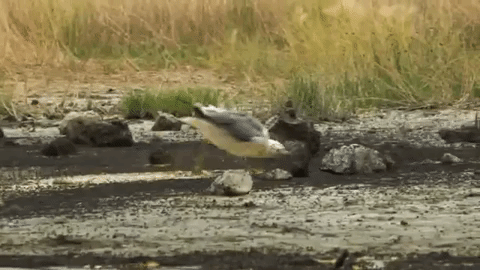If you’ve been to the beach, you’ve probably witnessed this familiar scene: a screeching gull swooping down to snatch a sandwich or a hot dog. Most know the birds as scavengers.
But to Kristie Nelson, the Mono Lake Gull Project manager for Point Blue Conservation Science, gulls are much more than that. “When you stop and observe and pay attention, there’s so much intricacy in gulls,” she says.
Nelson conducts her research at Mono Lake in California, an inland salty lake that is home to one of the few, massive colonies of gulls. At the height of breeding season, the population can range from 27,000 to 65,000. “The islands are just covered in gulls, nesting in these incredibly dense colonies,” she says. “When we’re out there working, you’ve got to kind of yell to each other because of the din of the birds.”
“Anything that can survive this highly-caustic, salty lake water is an amazing animal,” she says.
The majority of gulls in the colony primarily live near the ocean. But when it’s time to breed, most of them migrate to saline bodies of water like Mono Lake, which is about 200 miles east of San Francisco. When the young gulls are ready to fly, they migrate back to the coast.
While at the lake, the gulls primarily subsist on alkali flies, which appear in thick swarms once the weather warms up. “The technique the gulls mostly use is to open their mouth as wide as they can, and run as quickly as they can,” Nelson says. “And it’s pretty entertaining to watch.”

Nelson’s team studies the relationships of the birds and monitors the colony’s health. “We want gulls to be an indicator of ecosystem health,” she says. And that ecosystem has gone through a lot of changes over the course of their 35 year-old data set.
When Nelson and her colleagues began the study in 1983, the future of the gull colony was uncertain. Mono Lake is a water sources for Los Angeles—the city diverts fresh water that flows into the lake when the snowpack melts, and the lake was shrinking. In 1994, caps were put in place on the amount of water the city could divert so that Mono Lake’s ecosystem could be protected, but the lake is still under threat. “[When] those limits were created in 1994, we didn’t expect climate change,” says Nelson.
As California has gotten warmer, the state has seen more extreme droughts. Mono Lake is losing more water than the 1994 caps accounted for, threatening to connect the traditional roosting islands to the mainland. “And because they’re nesting on the ground,” Nelson says, “if a coyote were to get out onto these colonies, they can just decimate the population.”
Changes in runoff have also worsened the salinity conditions in the lake. “Those salinity conditions depress the lake ecosystem, depress the nutrient cycling, that ultimately have negative effects on the gulls and other birds.”
“I feel somewhat optimistic about the success in the future for the gulls,” Nelson says, “but I think that will take support and science from us humans. Seeing them forage out on this lake that can be so incredibly inhospitable—they’re a part of a vibrant Mono Lake ecosystem, and Mono Lake wouldn’t be the same without them.”
Credits
Produced by Luke Groskin
Filmed by Christian Baker
Music by Audio Network
Article by Daniel Peterschmidt
Additional Footage Provided by Ryan Christensen/Bristlecone Media, Mono Lake Committee, Shutterstock, NASA Earth Observatory, Erik Olsen (CC BY 3.0), Vorm Sterber (C.C. BY 2.0),Seamus Campbell (C.C. BY 2.0)
Meet the Producers and Host
About Luke Groskin
@lgroskinLuke Groskin is Science Friday’s video producer. He’s on a mission to make you love spiders and other odd creatures.
About Dee Peterschmidt
Dee Peterschmidt is a producer, host of the podcast Universe of Art, and composes music for Science Friday’s podcasts. Their D&D character is a clumsy bard named Chip Chap Chopman.